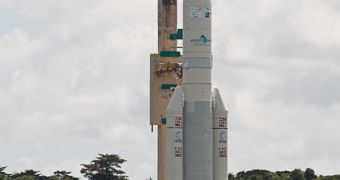Officials at the European Space Agency (ESA) announce that the Hylas-1 satellite has made its way to the launch site yesterday, and that it is now ready for its take-off to Earth's orbit, scheduled for today.
The spacecraft will travel to space from the Kourou Spaceport, in French Guiana, South America. ESA decided to launch the satellite, and the Intelsat-17 spacecraft that will accompany it, aboard an Ariane 5 heavy-lift delivery system.
The agency decided to go with this rocket because its manufacturer, European company Arianespace, has an excellent track record, while at the same time providing enough payload bay volume to accommodate the satellite.
Hylas-1, whose name stands for Highly Adaptable Satellite, was built to provide worldwide customers with innovative services including High Definition Television (HDTV) and interactive satellite-delivered broadband programs, among others.
It arrived in French Guyana on Monday, October 11, aboard a massive Antonov An-124 cargo airplane, and it was transported to the Final Assembly Building (FAB) on November 17.
In the mean time, it underwent a series of tests meant to ensure that all systems were functioning within parameters, and that the spacecraft will function once it reaches its operational geostationary orbit, at an altitude of about 36,000 kilometers above Earth.
FAB operations – which included sealing Hylas-1 and Intelsat 17 in the Ariane 5 payload fairing – ended on November 21, and so the rocket was attached to its launch facility yesterday.
The Ariane Launch Complex No.3 features a huge 2000-ton mobile take-off platform that is generally used for such rocket missions. Of 51 flights carried out with Ariane 5 rockets, only two failed, last of which was in 2002.
Weather looks promising for tonight's launch window, which lasts between19.39 and 22.54 CET. The event can be followed live on the ESA website here.
“ESA and [company] Avanti [Communications] signed the contract in 2006 for the development of Hylas, supporting the most innovative elements of this new system,” ESA officials said.
“The satellite is designed to have a lifetime of 15 years, and will be launched into a geostationary orbit at 33.5°W,” they added early on in the spacecraft's testing phase.
“While its payload has been developed in Europe, Hylas-1’s flight-proven I-2K satellite platform was procured by prime contractor EADS Astrium from Antrix Corporation in India, the commercial arm of the Indian Space Research Organization (ISRO),” ESA officials said more recently.

 14 DAY TRIAL //
14 DAY TRIAL //